Low-Complexity Synchronization Scheme with Low-Resolution ADCs
Abstract
1. Introduction
2. OFDM Equivalent Signal Model
2.1. Principle of OFDM
2.2. Effect of Synchronization Bias on OFDM System
3. Analysis of Synchronization Algorithm
3.1. Training Sequence Design
3.2. Low-Resolution Quantization Scheme
3.3. Feedback-Based Synchronization Scheme with Low-Resolution ADCs
4. System Analysis and Simulation Results
4.1. Simulation System Parameters
4.2. Quantization Effects of Timing Synchronization
4.3. BER and MSE with Low-Resolution ADCs
4.4. Constellation Comparison
4.5. Performance Analysis
5. Conclusions
Author Contributions
Funding
Conflicts of Interest
References
- Andrews, J.G.; Buzzi, S.; Choi, W.; Hanly, S.V.; Lozano, A.E.; Soong, A.C.K.; Zhang, J. What Will 5G Be? IEEE J. Sel. Areas Commun. 2014, 32, 1065–1082. [Google Scholar] [CrossRef]
- Shen, X.; Guizani, M.; Qiu, R.C.; Le-Ngoc, T. Ultra-Wideband Wireless Communications and Networks; John Wiley & Sons, Inc.: Hoboken, NJ, USA, 2006. [Google Scholar]
- Lee, J.S.; Su, Y.W.; Shen, C.C. A comparative study of wireless protocols: Bluetooth, UWB, ZigBee, and Wi-Fi. In Proceedings of the IECON 2007—33rd Annual Conference of the IEEE Industrial Electronics Society, Taipei, Taiwan, 5–8 November 2007. [Google Scholar]
- Porcino, D.; Hirt, W. Ultra-wideband radio technology: Potential and challenges ahead. IEEE Commun. Mag. 2003, 41, 66–74. [Google Scholar] [CrossRef]
- Tatsis, G.; Votis, C.; Raptis, V.; et al. Performance of UWB-Impulse Radio Receiver Based on Matched Filter Implementation with Imperfect Channel Estimation. In American Institute of Physics Conference Series; American Institute of Physics: College Park, MD, USA, 2010. [Google Scholar]
- Tatsis, G.; Christofilakis, V.; Votis, C.; et al. BER Performance of an Ultra-Wideband Impulse Radio Correlator Receiver. Wseas Trans. Inf. Sci. Appl. 2011, 8, 401–406. [Google Scholar]
- Ranjan, M.; Larson, L.E. A Low-Cost and Low-Power CMOS Receiver Front-End for MB-OFDM Ultra-Wideband Systems. IEEE J. Solid-State Circuits 2007, 42, 592–601. [Google Scholar] [CrossRef]
- Yue, G.; Ge, L.; Li, S. Analysis of ultra wideband signal interference to DSSS receiver. In Proceedings of the IEEE Workshop on Signal Processing Advances in Wireless Communications, Rome, Italy, 15–18 June 2003. [Google Scholar]
- Rappaport, T.S.; Sun, S.; Mayzus, R.; Zhao, H.; Azar, Y.; Wang, K.; Wong, G.N.; Schulz, J.K.; Samimi, M.; Gutierrez, F. Millimeter Wave Mobile Communications for 5G Cellular: It Will Work! IEEE Access 2013, 1, 335–349. [Google Scholar] [CrossRef]
- Angelis, C.T.; Chronopoulos, S.K. System Performance of an LTE MIMO Downlink in Various Fading Environments. In Ambient Media and Systems; Springer: Berlin/Heidelberg, Germany, 2011. [Google Scholar]
- Larsson, E.G.; Edfors, O.; Tufvesson, F.; Marzetta, T. Massive MIMO for Next Generation Wireless Systems. IEEE Commun. Mag. 2013, 52, 186–195. [Google Scholar] [CrossRef]
- Jiang, T.; Wu, Y. An Overview: Peak-to-Average Power Ratio Reduction Techniques for OFDM Signals. IEEE Trans. Broadcast. 2008, 54, 257–268. [Google Scholar] [CrossRef]
- Lim, J.; Myung, H.G.; Oh, K.; Goodman, D.J. Channel-Dependent Scheduling of Uplink Single Carrier FDMA Systems. In Proceedings of the Vehicular Technology Conference, Montreal, QC, USA, 25–28 September 2006; pp. 1–5. [Google Scholar]
- Tsiropoulou, E.E.; Kapoukakis, A.; Papavassiliou, S. Energy-efficient subcarrier allocation in SC-FDMA wireless networks based on multilateral model of bargaining. In Proceedings of the IFIP Networking Conference, Brooklyn, NY, USA, 22–24 May 2013; pp. 1–9. [Google Scholar]
- Chronopoulos, S.K.; Tatsis, G.; Raptis, V.; Kostarakis, P. Enhanced PAPR in OFDM without Deteriorating BER Performance. Int. J. Commun. Netw. Syst. Sci. 2011, 4, 164–169. [Google Scholar] [CrossRef]
- Chronopoulos, S.K.; Christofilakis, V.; Tatsis, G.; Kostarakis, P. Reducing Peak-to-Average Power Ratio of a Turbo Coded OFDM. Wirel. Eng. Technol. 2012, 3, 195–202. [Google Scholar] [CrossRef]
- Murmann, B. ADC Performance Survey 1997–2013. Available online: https://web.stanford.edu/~murmann/adcsurvey.html (accessed on 7 December 2018).
- Singh, J.; Madhow, U. Phase-Quantized Block Noncoherent Communication. IEEE Trans. Commun. 2013, 61, 2828–2839. [Google Scholar] [CrossRef]
- Sobel, D.A.; Brodersen, R.W. A 1 Gb/s Mixed-Signal Baseband Analog Front-End for a 60 GHz Wireless Receiver. IEEE J. Solid-State Circuits 2009, 44, 1281–1289. [Google Scholar] [CrossRef]
- Wadhwa, A.; Madhow, U. Near-Coherent QPSK Performance with Coarse Phase Quantization: A Feedback-Based Architecture for Joint Phase/Frequency Synchronization and Demodulation. IEEE Trans. Signal Process. 2016, 64, 4432–4443. [Google Scholar] [CrossRef]
- Chronopoulos, S.K.; Votis, C.; Raptis, V.; Tatsis, G.; Kostarakis, P. In depth analysis of noise effects in orthogonal frequency division multiplexing systems, utilising a large number of subcarriers. In Proceedings of the AIP Conference Proceedings, La Herradura, Spain, 13–17 September 2010; Volume 1203, pp. 967–972. [Google Scholar]
- Sklar, B. Digital Communications: Fundamentals and Applications; Publishing House of Electronics Industry: Beijing, China, 2006. [Google Scholar]
- Xuejian, T.; Tao, L. Principle and Application of OFDM Mobile Communication Technology; People’s Post and Telecommunications Press: Beijing, China, 2003. [Google Scholar]
- Tsiligkaridis, T.; Forsythe, K.W. A sequential Bayesian inference framework for blind frequency offset estimation. In Proceedings of the IEEE International Workshop on Machine Learning for Signal Processing, Boston, MA, USA, 17–20 September 2015. [Google Scholar]
- Xu, G.Y. Research and Implementation of Synchronization in OFDM-UWB System. Master’s Thesis, Southeast University, Nanjing, China, 2010. (In Chinese). [Google Scholar] [CrossRef]
- Zhang, H.; Zhao, Q.; Xu, F. Impact of integer carrier frequency offset on the performance of frequency-domain contention. Electron. Lett. 2017, 53, 970–972. [Google Scholar] [CrossRef]
- Minn, H. On Timing Offset Estimation for OFDM Systems. IEEE Commun. Lett. 2000, 4, 242–244. [Google Scholar] [CrossRef]
- Chronopoulos, S.; Christofilakis, V.; Tatsis, G.; Kostarakis, P. Performance of Turbo Coded OFDM under the Presence of Various Noise Types. Wirel. Pers. Commun. Int. J. 2016, 87, 1319–1336. [Google Scholar] [CrossRef]
- Mollen, C.; Choi, J.; Larsson, E.G.; Heath, R.W. Performance of the Wideband Massive Uplink MIMO with One-Bit ADCs. IEEE Trans. Wirel. Commun. 2016, 16, 87–100. [Google Scholar] [CrossRef]
- Schmidl, T.M.; Cox, D.C. Robust frequency and timing synchronization for OFDM. IEEE Trans. Commun. 2002, 45, 1613–1621. [Google Scholar] [CrossRef]
- Cho, Y.S.; Kim, J.; Yang, W.Y.; Cho, Y.S. MIMO-OFDM Wireless Communications with MATLAB; Wiley: Hoboken, NJ, USA, 2010. [Google Scholar]
- Chiu, Y.; Nikolic, B.; Gray, P.R. Scaling of analog-to-digital converters into ultra-deep-submicron CMOS. In Proceedings of the IEEE Custom Integrated Circuits Conference, San Jose, CA, USA, 21 September 2005. [Google Scholar]
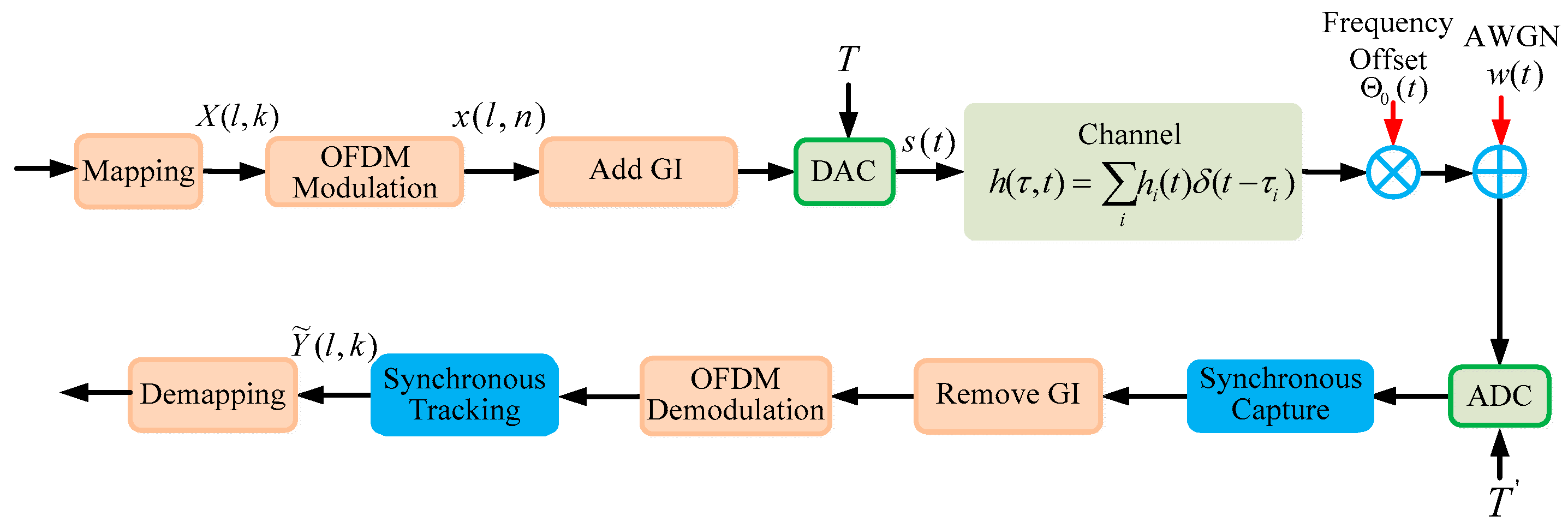
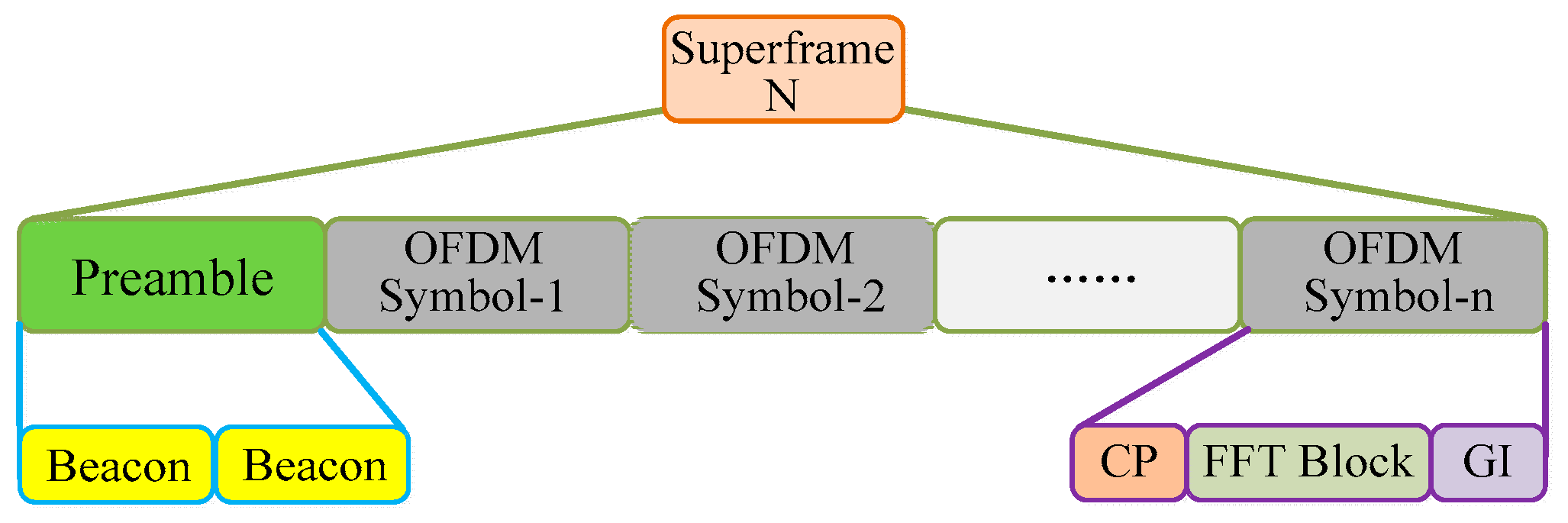


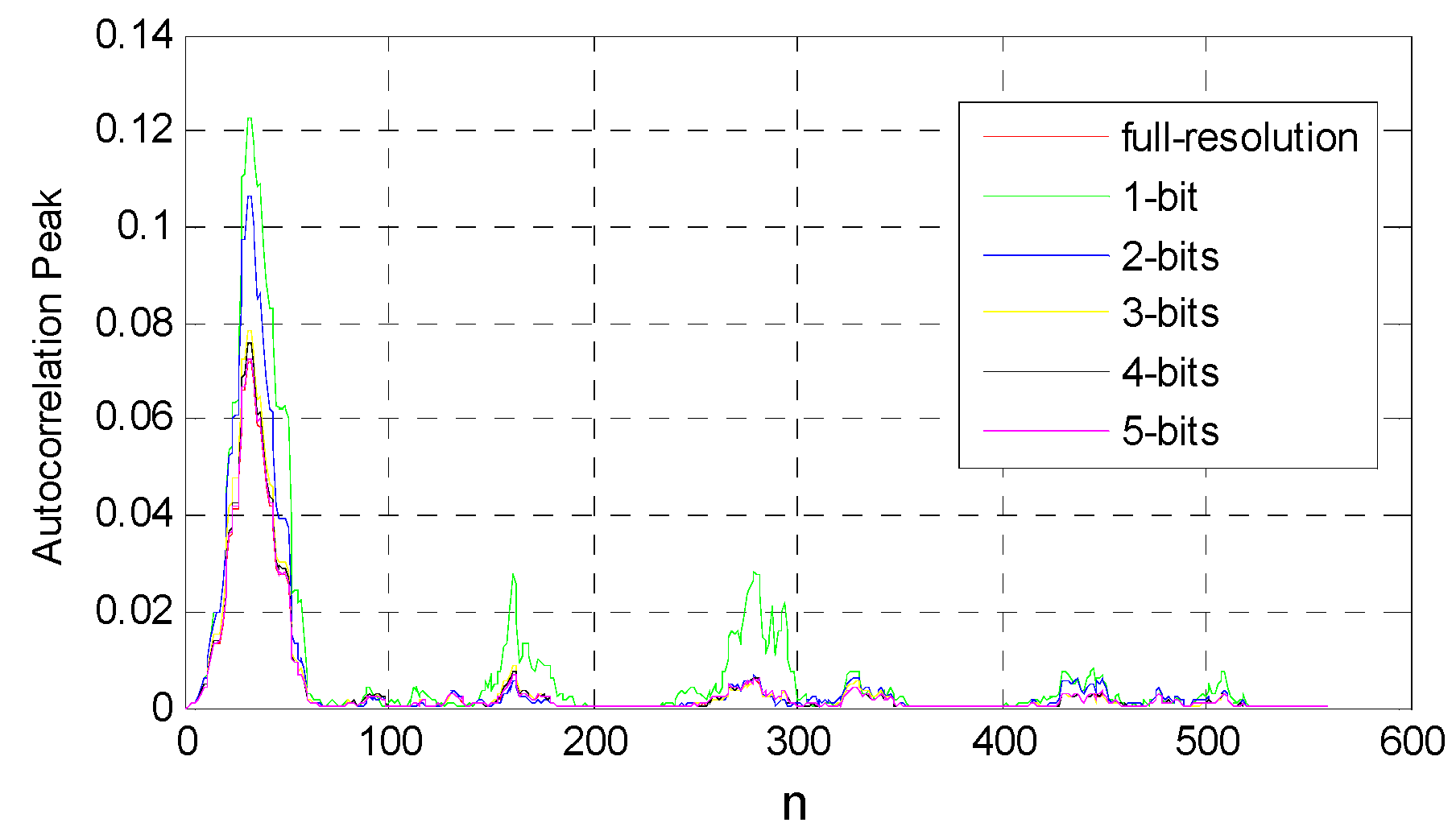
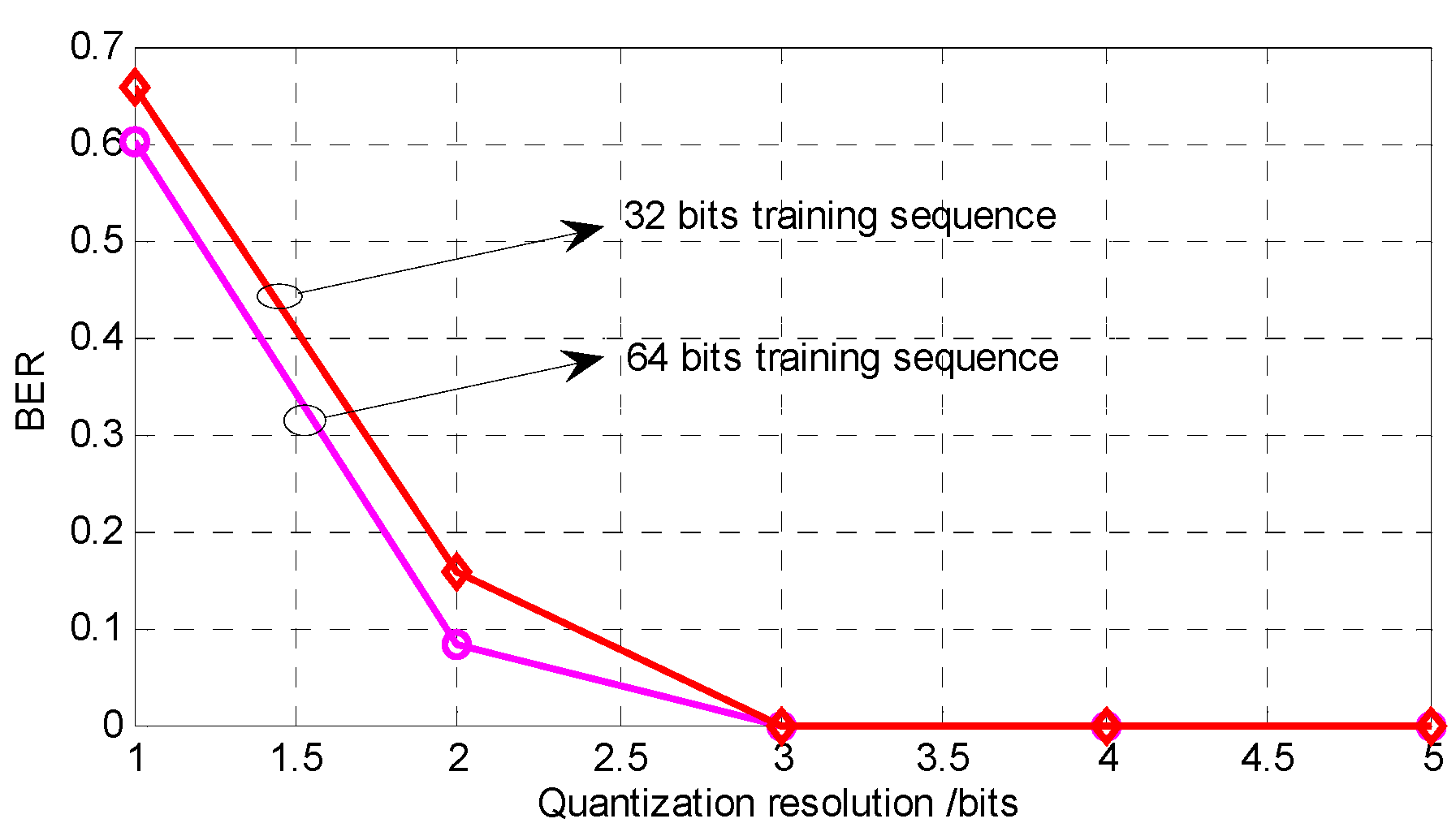
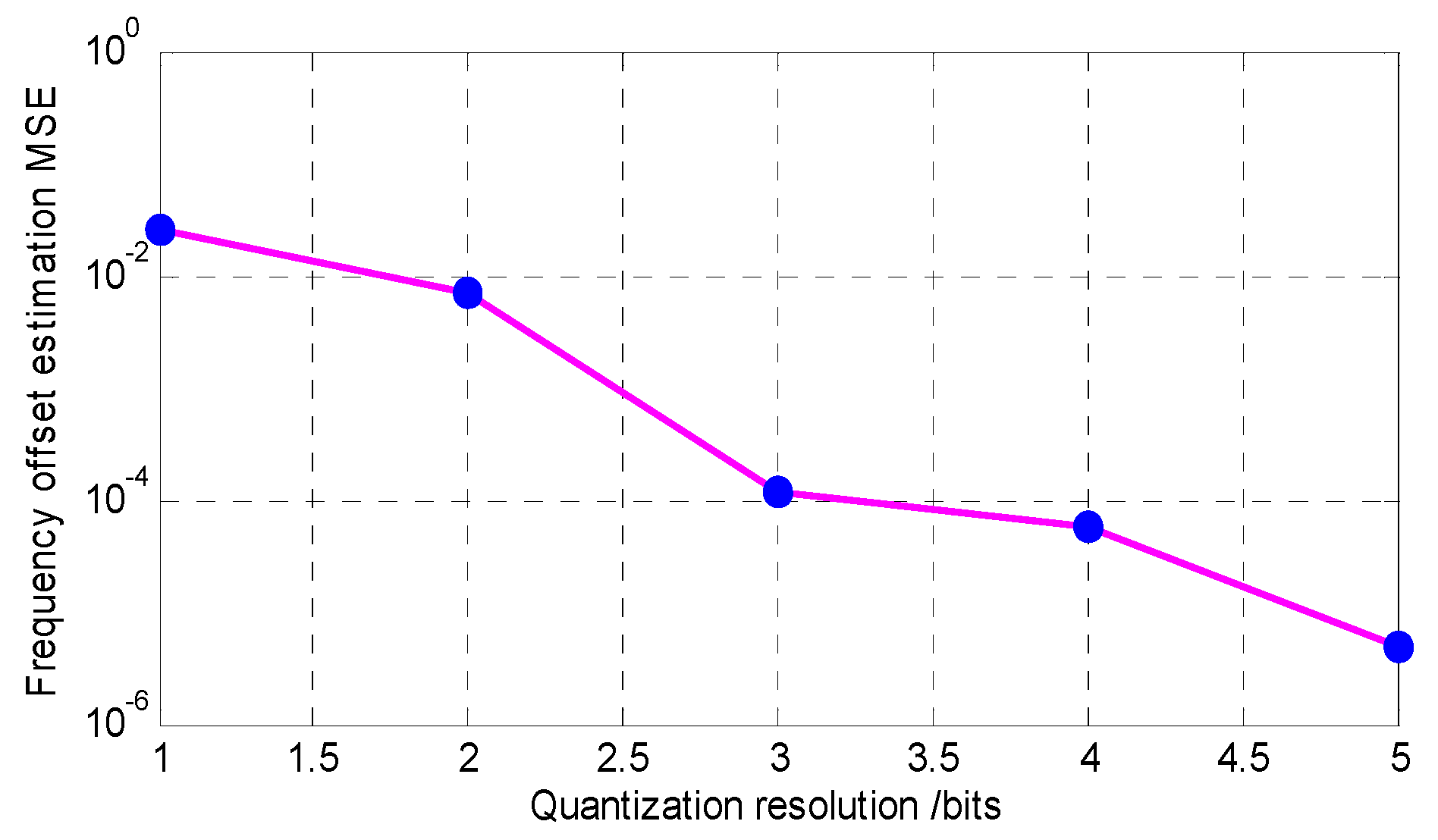

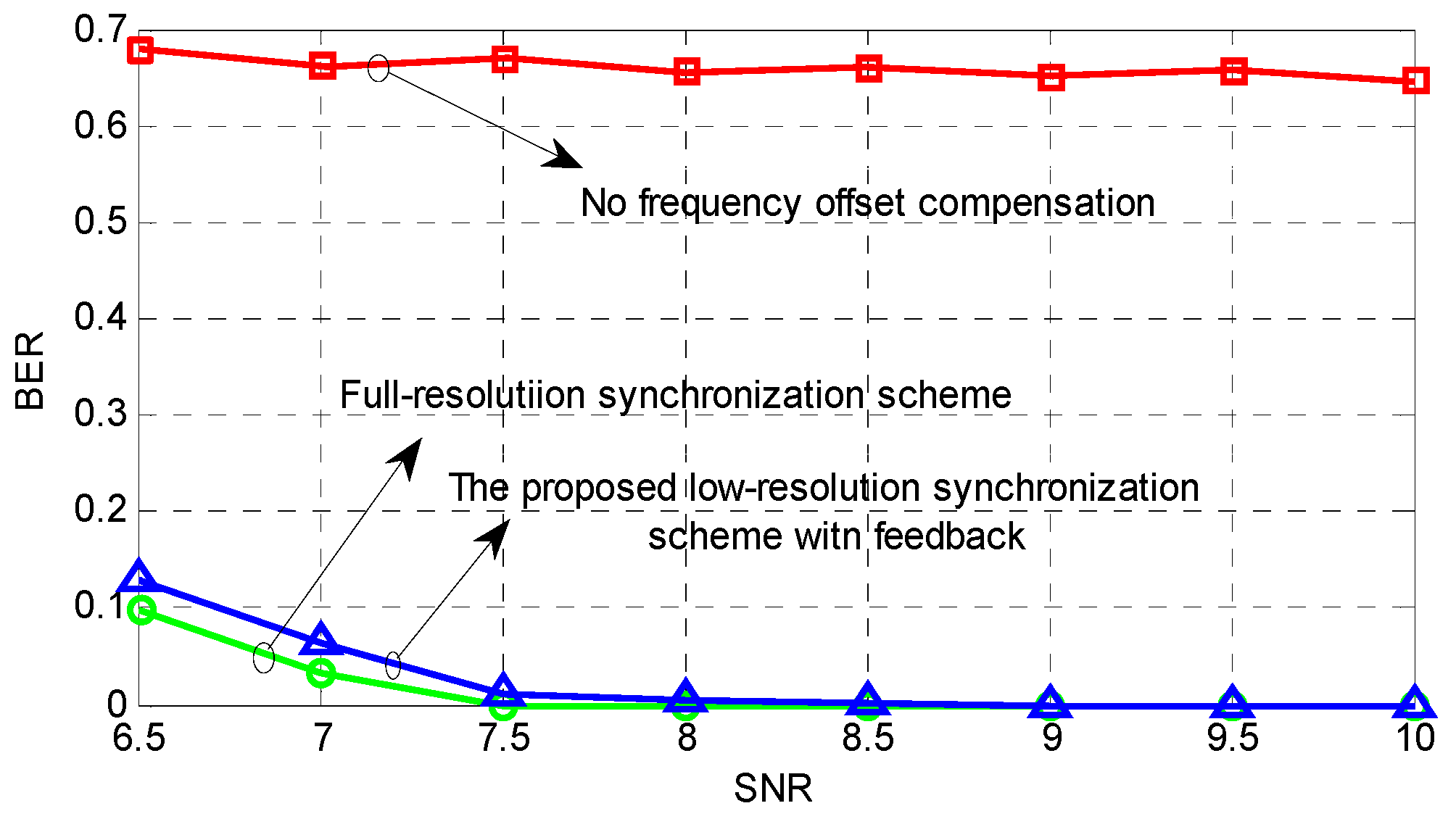
| Subcarrier | 1024 (1 K Model) |
|---|---|
| Modulation | QPSK |
| Quantization bits | 1/2/3/4/5 |
| Superframe length | 559 |
| FFT-points | 128 |
| OFDM symbol length | 128 |
| Guard interval | 32 |
| Training sequence length | 32/64 |
| SNR | 10 dB |
| Frequency offset | 0.2 |
| Channel delay | 1 |
| Sampling point number | 8 |
| Roll-off factor | 0.5 |
© 2018 by the authors. Licensee MDPI, Basel, Switzerland. This article is an open access article distributed under the terms and conditions of the Creative Commons Attribution (CC BY) license (http://creativecommons.org/licenses/by/4.0/).
Share and Cite
Jun, L.; Zhongqiang, L.; Xingzhong, X. Low-Complexity Synchronization Scheme with Low-Resolution ADCs. Information 2018, 9, 313. https://doi.org/10.3390/info9120313
Jun L, Zhongqiang L, Xingzhong X. Low-Complexity Synchronization Scheme with Low-Resolution ADCs. Information. 2018; 9(12):313. https://doi.org/10.3390/info9120313
Chicago/Turabian StyleJun, Liu, Luo Zhongqiang, and Xiong Xingzhong. 2018. "Low-Complexity Synchronization Scheme with Low-Resolution ADCs" Information 9, no. 12: 313. https://doi.org/10.3390/info9120313
APA StyleJun, L., Zhongqiang, L., & Xingzhong, X. (2018). Low-Complexity Synchronization Scheme with Low-Resolution ADCs. Information, 9(12), 313. https://doi.org/10.3390/info9120313





